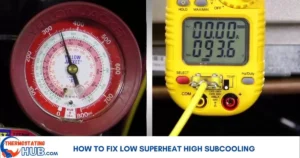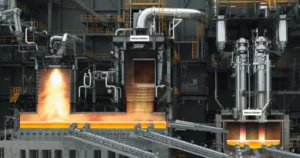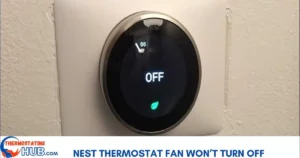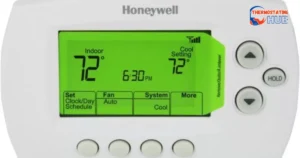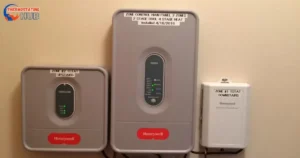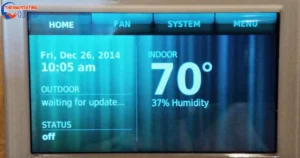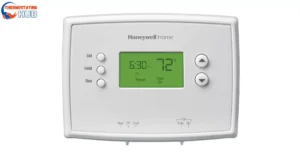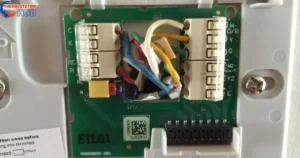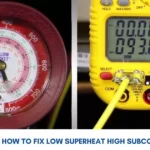Encountering the Dometic Thermostat E1 Code signals a communication glitch between the Dometic AC system and its sensors or circuit control board. This error commonly points to issues within the system’s communication network.
The Dometic AC system is intricately designed to exchange information among its key components:
- Front Temp Sensor and Front AC:
The thermostat unit houses the front temp sensor, establishing communication with the Front AC unit.
- Between Front AC and Rear AC Control Boards:
Communication pathways extend between the control boards of the Front AC and Rear AC units, ensuring seamless operation.
- Rear Temp Sensor and Rear AC:
The rear temp sensor communicates crucial data with the Rear AC unit, contributing to overall system coordination.
When the E1 Code surfaces, it indicates disruptions in these communication channels, hindering the proper functioning of your Dometic AC system.
Possible causes for the Dometic thermostat E1 error code
| Issues | Main Fix |
| Faulty Thermostat | Reset thermostat |
| Loose Connectors between Thermostat and AC | Unplug and securely attach connectors |
| Dirty Connectors between Thermostat and AC | Clean and reattach connectors |
| High Temperatures | Hold a bag of ice up to the thermostat (strange but works) |
| Malfunctioning Control Board | Replace the control board unit |
Before You Start Troubleshooting, follow these essential steps before diving into the resolution process. Turn off the circuit breaker to cut power. If applicable, engage the battery disconnect switch.
Read also: How to Reset Dometic Thermostat?
These precautions create a safe environment for troubleshooting and maintenance, reducing the risk of electrical issues.
Faulty thermostat
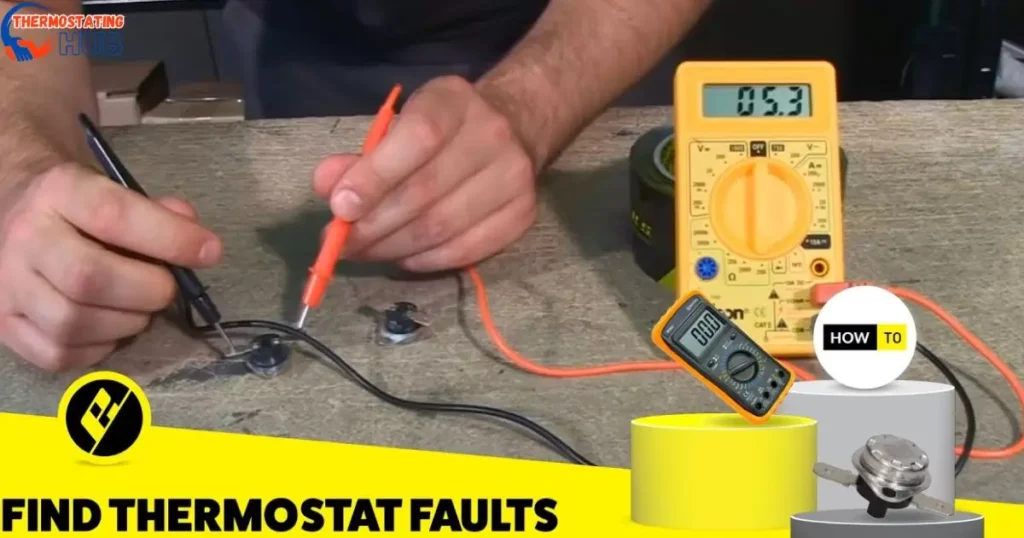
Before delving deeper into troubleshooting the E1 code, it’s crucial to eliminate the possibility of a faulty thermostat. Often, this code arises due to issues within the thermostat, and a simple reset is needed.
Here’s how to rule out a faulty thermostat:
Ensure the thermostat registers at least one zone; you can control that zone directly from the thermostat. If successful, the thermostat and its connection are likely functioning correctly, and no further troubleshooting is required.
The Fix:
If the unit cannot register any zones, focus on the main RJ11 connector from the thermostat or consider it potentially faulty. Examine the main connector cable for any issues. If the line is in good condition, it may be time to explore replacing the thermostat.
Pro Tip: Regularly check thermostat functionality to catch potential issues early. If the thermostat fails to register any zones, investigate the main RJ11 connector and, if needed, consider replacing the thermostat for optimal system performance.
High temperatures
In scorching temperatures exceeding 100°F, the Dometic thermostat E1 code may appear unwelcome. During extreme heat, the thermostat’s communication with the circuit control board or other sensors might falter, triggering the display of the E1 code.
The Fix:
In a peculiar yet effective turn, a remedy for this issue involves holding ice blocks to the thermostat. This unconventional method helps cool down the thermostat, prompting the AC to kick in and often causing the E1 code to vanish. Surprisingly, this solution, recommended by Dometic support, has proven quite effective.
Pro Tip: When faced with the E1 code in excessively high temperatures, the ice block trick can provide a quick and unexpected solution. However, consider addressing any underlying issues and consulting with Dometic support for a more permanent fix. Stay cool in the heat!
Dirty connectors between Thermostat and AC
If your RV AC has been running for an extended period without service, it might be the opportune time for a thorough cleaning, especially when faced with the persistent display of the E1 code on the thermostat. According to the manual, this code indicates connection issues, often stemming from dirty connectors.
The Fix:
Initiate the solution by unplugging all RJ11 terminal plugs and conducting a meticulous inspection for dirt or debris. Clean the plugs as necessary, ensuring they are free from corrosion and loose wires. In a dual AC ducted system, each AC unit control board hosts two RJ11 plugs labeled “P1” and “P2” on the schematic.
After cleaning the plugs with an aerosol CRC electronic cleaner or a similar solution, reinitialize the thermostat:
- Turn the thermostat OFF.
- Simultaneously hold down the “Zone” and “Mode” buttons until the zones register.
Note: Turn the battery disconnect switch back on for this step, but you don’t need to activate the AC breakers. If both zones register simultaneously, the problem is likely resolved. If only one zone registers, continue troubleshooting.
Read also: Nest Thermostat Blowing Hot Air On Cool
Malfunctioning control board
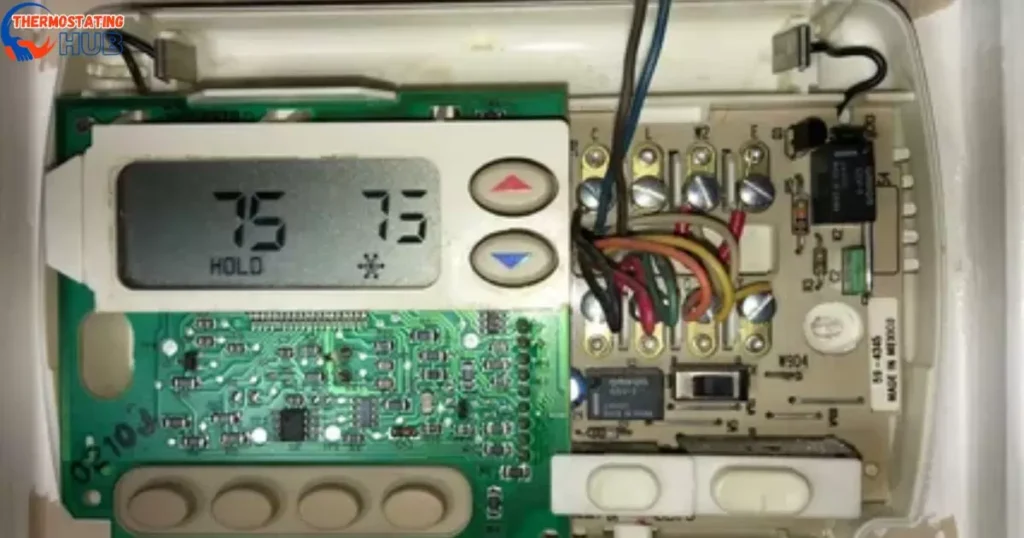
If thorough inspection confirms that cables and plugs are in good working order, the culprit behind the persistent E1 code may be the Dometic AC control board. Consider checking and, if necessary, replacing this crucial component.
The control board acts as the brain of the AC, processing and transmitting signals from the thermostat to other components of the AC system. When this essential part becomes defective, it interrupts communication from the thermostat, potentially triggering the E1 code.
Accessing the Control Board:
To access the control board on the roof, follow these steps:
- On the roof, remove the plastic AC cover by unscrewing the four screws.
- Locate and remove the AC control board cover on the front right side of each AC unit, secured by two hex screws.
- Depending on your preference, free the control board from its corner mounts or attempt to wiggle the RJ11 plugs with the control board in place.
The Fix:
A malfunctioning control board might be due to a blown fuse on the circuit control board. Check the 5 AMP fuse for continuity; if it’s blown, replace it. You can also swap control boards between the rear and front AC units.
Replacing the circuit control board becomes the final option if the fuse isn’t the issue. However, exercise caution and seek professional advice when considering replacement.
Pro Tip: When dealing with the circuit control board, ensure you understand well or consult a professional to avoid further complications. A blown fuse is typical, but thorough diagnostics may be necessary for a precise solution.
Pro Strategies to Prevent and Address Dometic Thermostat E1 Code Issues
Regular Maintenance:
Implement a routine schedule for cleaning and inspecting connectors and cables. Regular maintenance can prevent E1 code issues by ensuring optimal communication between the thermostat and AC components.
Temperature Management:
Be mindful of extreme temperatures, as they can contribute to communication disruptions. Consider using the ice block method to cool down the thermostat temporarily, especially in high-temperature conditions.
Thermostat Functionality Checks:
Regularly check if the thermostat registers zones and can control them. This quick check can help rule out a faulty thermostat and identify potential issues early.
Professional Consultation:
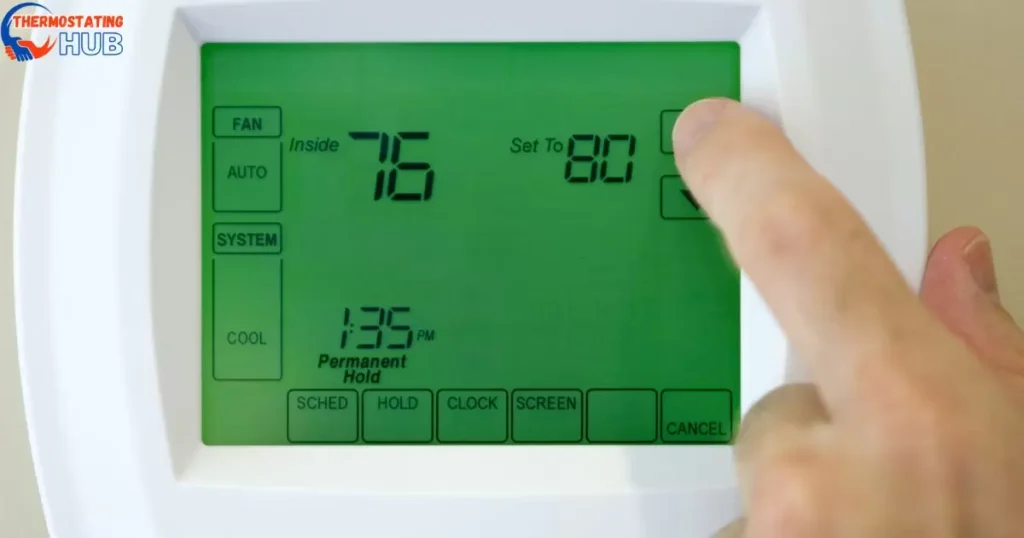
If troubleshooting doesn’t resolve the E1 code or control board issues are suspected, seek professional advice. Handling circuit control boards and complex AC components may require specialized knowledge.
Fuse Inspection:
Inspect the 5 AMP fuse on the circuit control board in case of malfunctions. If blown, replace it. Swapping control boards between rear and front AC units can be a diagnostic step before considering a replacement.
Read also: What is Nest Heat Pump Balance?
Safe Disconnection:
Before any troubleshooting, ensure safety by disconnecting the power. Turn off the circuit breaker and, if applicable, engage the battery disconnect switch to create a secure environment for inspection and maintenance.
Pro Tip: Preventive measures, regular checks, and cautious handling during troubleshooting contribute to a more reliable and efficient RV AC system, minimizing the chances of encountering the E1 code.
Navigating Dometic Thermostat E1 Code: Advantages and Drawbacks
| Advantages | Drawbacks |
| 1. DIY Troubleshooting: With clear steps, users can attempt DIY solutions for common issues. | 1. Limited Diagnosis: DIY troubleshooting may not address complex problems, requiring professional intervention. |
| 2. Quick Fixes: The ice block method provides a quick, albeit temporary, solution in high-temperature scenarios. | 2. Unconventional Fixes: The ice block method may be considered unconventional and not a long-term solution. |
| 3. Cost-Efficient Initial Steps: Checking cables and connectors is a cost-effective first step. | 3. Potential Component Costs: If control board replacement is needed, costs may rise, prompting consideration of professional consultation. |
| 4. Routine Maintenance: Regular cleaning can prevent E1 code issues, contributing to system longevity. | 4. Time-Consuming: In-depth troubleshooting and maintenance can be time-consuming, affecting immediate comfort. |
| 5. User Awareness: Understanding thermostat functionalities enables users to identify potential issues early. | 5. Risk of Damage: Inexperienced handling during troubleshooting poses a risk of damage to components. |
| 6. Environmental Adaptation: The ice block method adapts to extreme temperatures without immediate repairs. | 6. Temporary Solutions: Quick fixes may only address symptoms temporarily without resolving root causes. |
⚙️ Pro Tip: While DIY steps offer initial advantages, complex issues may require professional attention. Regular maintenance and awareness of thermostat functionalities can contribute to a more reliable RV AC system.
Dometic Thermostat E1 Code: Essential Insights for Success
- Temperature Impact: The E1 code often arises in extreme temperatures exceeding 100°F, impacting the thermostat’s communication with the AC system components.
- Ice Block Fix: Holding blocks of ice to the thermostat can provide a quick but temporary solution, cooling the thermostat and prompting the AC to resume operation.
- Routine Maintenance: Regularly clean and inspect connectors and cables to prevent E1 code issues, ensuring smooth communication between the thermostat and AC components.
- Faulty Thermostat Check: Rule out a faulty thermostat by verifying if it registers zones and can control them. If not, further inspection or replacement may be necessary.
- Control Board Examination: If cables are in order, inspect the control board on the roof. Check for blown fuses and consider swapping control boards between rear and front AC units for diagnostic purposes.
- Safety First: Disconnect power before troubleshooting by turning off the circuit breaker and, if applicable, engaging the battery disconnect switch.
- Professional Consultation: Seek professional advice if DIY troubleshooting does not resolve the E1 code or if there are concerns about control board issues. Complex components may require specialized knowledge.
- Cost Consideration: While DIY steps are cost-effective initially, be aware that potential component replacements, especially the control board, may incur additional costs.
- Time Management: Remember that troubleshooting and routine maintenance can be time-consuming, impacting immediate comfort. Plan accordingly for downtime.
- Awareness is Key: Understanding the thermostat’s functionalities and being aware of potential issues contribute to successful troubleshooting and maintenance.
Answers To Key Questions
How do I fix E1 error on my thermostat?
To resolve an E1 error on your thermostat, begin by turning off the power. Wait for a few minutes, and then turn it back on. If the error persists, refer to the thermostat manual for model-specific troubleshooting steps or contact the manufacturer for assistance.
How do I clear the E1 code on my Dometic thermostat?
Clearing the E1 code on a Dometic thermostat involves turning off the power, waiting, and then turning it back on. If the issue persists, consult the thermostat manual or contact Dometic customer support for guidance.
How do I fix E1 error?
For general E1 errors, attempt a reset by turning off the device and powering it back on after a few minutes. Check the device manual for specific troubleshooting steps or contact customer support for model-specific guidance.
What is the E1 code on my RV?
The E1 code on an RV signals a thermostat or control system error. Start by resetting the thermostat or consult the manual for specific instructions. If the issue persists, contact the RV manufacturer or thermostat provider for further assistance.
Final Thoughts
Now that you’ve gained insights into the potential causes of the E1 code on your Dometic thermostat, we hope you’ve successfully addressed the issue. However, if the problem persists despite your efforts, we strongly encourage you to seek the assistance of professionals.
HVAC technicians possess the expertise to diagnose and rectify complex thermostat issues, ensuring your system operates smoothly. Feel free to reach out for professional help to guarantee optimal functionality.
Thank you for taking the time to read this article! If you have any additional questions or need more help, please don’t hesitate to ask. I appreciate your engagement! 📚😊

I’m James Wilson, your HVAC maestro from “Thermostating Hub.” Elevate your comfort with my expertise in heating, ventilation, and air conditioning. Let’s transform your space into a haven of perfect temperatures, tackling HVAC issues with precision and enthusiasm.
![Dometic Thermostat E1 Code [Causes + Fix]](https://thermostatinghub.com/wp-content/uploads/2023/12/dometic-thermostat-e1-code-causes-fix.webp)



